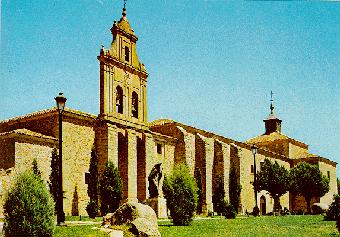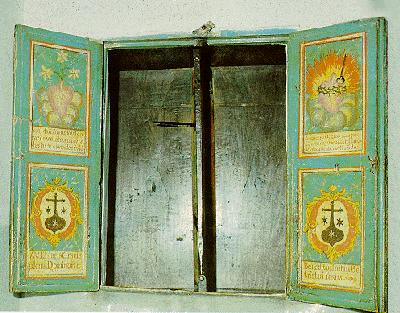
 Gerd arrived in Avila at last, knowing no one and speaking not a word of Spanish. She took a tiny room
near the station, and went to the convent of La Encarnación, where St. Teresa spent 27 years of her
religious life, and where the first and most famous of her mystical encounters with "His Majesty" occurred,
and where the idea of the Reform was born. She went to the church every day, sitting through the mass.
Soon she asked the custodian whether she might help to clean the church. She was refused. So, every
day she picked up the trash from the street around the convent, and continued to come to the mass. It was
all she could think of to do. Meanwhile, sitting in the mass, she began to understand that God was
instructing her to become a Catholic. This was a very big step, very much at odds with all of her religious
upbringing and the deepest roots of ingrained bias, and she resisted. She says she sat in the mass
every day, "thinking bad thoughts about the priest!"
Gerd arrived in Avila at last, knowing no one and speaking not a word of Spanish. She took a tiny room
near the station, and went to the convent of La Encarnación, where St. Teresa spent 27 years of her
religious life, and where the first and most famous of her mystical encounters with "His Majesty" occurred,
and where the idea of the Reform was born. She went to the church every day, sitting through the mass.
Soon she asked the custodian whether she might help to clean the church. She was refused. So, every
day she picked up the trash from the street around the convent, and continued to come to the mass. It was
all she could think of to do. Meanwhile, sitting in the mass, she began to understand that God was
instructing her to become a Catholic. This was a very big step, very much at odds with all of her religious
upbringing and the deepest roots of ingrained bias, and she resisted. She says she sat in the mass
every day, "thinking bad thoughts about the priest!"
 Before long, the nuns came to hear of the strange woman practicing her devotion of cleaning up in the
street every day. The custodian told her she might help in the church. The custodian proved to be a
harsh and demanding tutor, and Gerd took the abuse without ever complaining. She was this much
nearer her unknowable goal, simply following her instincts and surrendering herself to them. She
began to take on odd jobs, painting and restoring furniture and doors, and the nuns have let her know
that they would make sure she never starved. What little money she had is running out.
Before long, the nuns came to hear of the strange woman practicing her devotion of cleaning up in the
street every day. The custodian told her she might help in the church. The custodian proved to be a
harsh and demanding tutor, and Gerd took the abuse without ever complaining. She was this much
nearer her unknowable goal, simply following her instincts and surrendering herself to them. She
began to take on odd jobs, painting and restoring furniture and doors, and the nuns have let her know
that they would make sure she never starved. What little money she had is running out.
 Gerd would converse on spiritual matters with the
Gerd would converse on spiritual matters with the  Prioress at the torno (turn), the lazy-susan type
device with a closable external shutter, that allows objects to be passed back and forth between the
nuns and visitors but prevents them from being seen. The nuns open the shutter by means of a chain
or rope during certain hours of the morning and afternoon. At last, just before a trip home to Denmark to
see her daughters and the grandchildren born since she left, she got up the courage to ask whether she
could hope to be received as a novice.
Prioress at the torno (turn), the lazy-susan type
device with a closable external shutter, that allows objects to be passed back and forth between the
nuns and visitors but prevents them from being seen. The nuns open the shutter by means of a chain
or rope during certain hours of the morning and afternoon. At last, just before a trip home to Denmark to
see her daughters and the grandchildren born since she left, she got up the courage to ask whether she
could hope to be received as a novice.
 The communities of the Primitive Carmelite rule are limited in number. For her to eventually enter, a nun
would have to die to open a place. There are 21 nuns in the community of La Encarnación. Two are
young Americans, one from Texas, who realized her surprising vocation only after coming to Avila. To
Gerd's question the Prioress answered "No."
The communities of the Primitive Carmelite rule are limited in number. For her to eventually enter, a nun
would have to die to open a place. There are 21 nuns in the community of La Encarnación. Two are
young Americans, one from Texas, who realized her surprising vocation only after coming to Avila. To
Gerd's question the Prioress answered "No."
Torno, Primitive Carmelite Convent of San José, Malagón
 Gerd continues to come daily to La Encarnación, but now comes also to San José, to sit in the church
and be with God. San José has begun to give her graces, indications of spiritual relationship and
guidance. Gerd did not say exactly how she experiences these indications. She described an event
she experienced in her kitchen, in the course of which God made her understand she must convert to
Catholicism. She has. She continues in her simple life, waiting for an understanding of the next steps
she must take.
Gerd continues to come daily to La Encarnación, but now comes also to San José, to sit in the church
and be with God. San José has begun to give her graces, indications of spiritual relationship and
guidance. Gerd did not say exactly how she experiences these indications. She described an event
she experienced in her kitchen, in the course of which God made her understand she must convert to
Catholicism. She has. She continues in her simple life, waiting for an understanding of the next steps
she must take.
 Seeing and hearing Gerd talk about her life and spiritual searching with such matter-of-factness and
certainty was for me like seeing and hearing St. Teresa. La Santa wrote in her conversational style of
events like being levitated during mystical conversations with the same total matter-of-factness.
Annette has asked me whether I believe St. Teresa actually levitated. I don't know how to answer.
Seeing and hearing Gerd talk about her life and spiritual searching with such matter-of-factness and
certainty was for me like seeing and hearing St. Teresa. La Santa wrote in her conversational style of
events like being levitated during mystical conversations with the same total matter-of-factness.
Annette has asked me whether I believe St. Teresa actually levitated. I don't know how to answer.
 I neither believe
nor disbelieve, and don't feel the need to decide for now, or perhaps ever. Still, seeing and hearing Gerd,
with her shining face and gentle smile of complete joy, her easy, if painful candor, was like sitting in the
presence, right now, in real time, of St. Teresa of Avila. And I thought, it's happened, the story has
happened, the event I didn't hope for, has happened!
I neither believe
nor disbelieve, and don't feel the need to decide for now, or perhaps ever. Still, seeing and hearing Gerd,
with her shining face and gentle smile of complete joy, her easy, if painful candor, was like sitting in the
presence, right now, in real time, of St. Teresa of Avila. And I thought, it's happened, the story has
happened, the event I didn't hope for, has happened!
 I was feeling by now overwhelmed. Gerd offered, if we had the time before leaving the next day, to take
us to La Encarnación for a special tour. I had been, but Annette hadn't, and I wanted to see it again,
through Gerd's eyes. We agreed to meet at 9:30.
I was feeling by now overwhelmed. Gerd offered, if we had the time before leaving the next day, to take
us to La Encarnación for a special tour. I had been, but Annette hadn't, and I wanted to see it again,
through Gerd's eyes. We agreed to meet at 9:30.

 Prioress at the torno (turn), the lazy-susan type
device with a closable external shutter, that allows objects to be passed back and forth between the
nuns and visitors but prevents them from being seen. The nuns open the shutter by means of a chain
or rope during certain hours of the morning and afternoon. At last, just before a trip home to Denmark to
see her daughters and the grandchildren born since she left, she got up the courage to ask whether she
could hope to be received as a novice.
Prioress at the torno (turn), the lazy-susan type
device with a closable external shutter, that allows objects to be passed back and forth between the
nuns and visitors but prevents them from being seen. The nuns open the shutter by means of a chain
or rope during certain hours of the morning and afternoon. At last, just before a trip home to Denmark to
see her daughters and the grandchildren born since she left, she got up the courage to ask whether she
could hope to be received as a novice.  I neither believe
nor disbelieve, and don't feel the need to decide for now, or perhaps ever. Still, seeing and hearing Gerd,
with her shining face and gentle smile of complete joy, her easy, if painful candor, was like sitting in the
presence, right now, in real time, of St. Teresa of Avila. And I thought, it's happened, the story has
happened, the event I didn't hope for, has happened!
I neither believe
nor disbelieve, and don't feel the need to decide for now, or perhaps ever. Still, seeing and hearing Gerd,
with her shining face and gentle smile of complete joy, her easy, if painful candor, was like sitting in the
presence, right now, in real time, of St. Teresa of Avila. And I thought, it's happened, the story has
happened, the event I didn't hope for, has happened! Chapter Twelve: "They Think I'm Crazy"
Chapter Twelve: "They Think I'm Crazy"